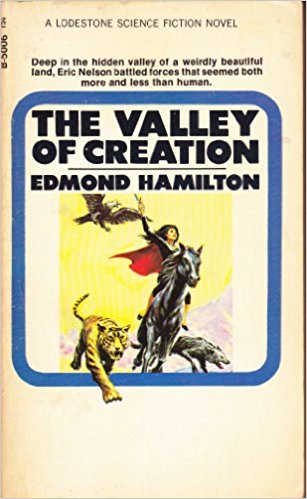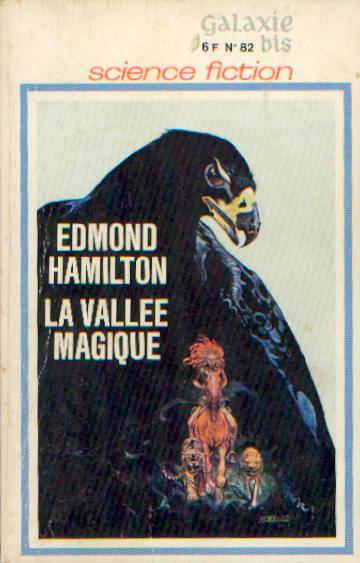Walk a Mile in My Paws: The Valley of Creation by Edmond Hamilton
 What I’ve learned from my still inadequate reading of pulp science-fiction legend Edmond Hamilton is his mastery of pushing his stories in expected directions but in unexpected ways. I’ve developed enough of a sense of how Hamilton viewed his characters and his attitude toward humanity that I can anticipate the direction he’ll flip a tale in the middle — but I’ll never anticipate how he’ll do it. Almost every time, he exceeds expectations by taking the most daring path, both for his narrative and his prose.
What I’ve learned from my still inadequate reading of pulp science-fiction legend Edmond Hamilton is his mastery of pushing his stories in expected directions but in unexpected ways. I’ve developed enough of a sense of how Hamilton viewed his characters and his attitude toward humanity that I can anticipate the direction he’ll flip a tale in the middle — but I’ll never anticipate how he’ll do it. Almost every time, he exceeds expectations by taking the most daring path, both for his narrative and his prose.
The 1948 novel The Valley of Creation follows a theme the author explored in his cliché-battering short story “A Conquest of Two Worlds” (Wonder Stories, 1932), where a human turns against the colonial tyranny of his own race to side with oppressed aliens. Hamilton often used a cynical, bleak approach in his short fiction, turning to a lighter adventure mode for his novels. The Valley of Creation falls into this pattern. It challenges readers with a protagonist who discovers he’s on the wrong side of a conflict — the side of racial supremacists — and switches allegiance. But it’s done as a science-fantasy adventure with the zip expected of the pulps and a heavy dose of A. Merritt’s “Lost World of Super Science!” explorations.
The Valley of Creation was published in Startling Stories for the July 1948 issue, sharing a table of contents with stories from Jack Vance and Henry Kuttner. Lancer published the paperback version in 1964, a time when the paperback market was mining for the gold spread throughout the pulp era that might otherwise have flaked away with the rough paper. Hamilton did revisions for the ‘64 version, updating the timeline so its protagonist, mercenary Eric Nelson, is a veteran of the Korean War.
At the opening of the novel, Nelson is in the position of many characters from noir movies and books of the late ‘40 and ‘50s: a disaffected military man who’s seen too much and has now lost his way. Nelson and his four mercenary partners are stranded in Central Asia at the end of their tether after their Chinese warlord employer is killed. They then receive a strange offer from a man named Shan Kar — he’ll pay them in platinum if they come to his valley of L’Lan and fight “the enemy of his people.”
The mercenaries are portrayed from the start as a dangerous and unlikable pack. Their one Chinese member, Lin Ki, is the only one who fights for ideals, but those ideals shriveled away when the warlord died. Nelson describes the others with brutal honesty: “Nick Sloan was a cool and ruthless self-seeker, Von Voss a moronic sadist, and Lefty Wister a spidery criminal.” As for Eric Nelson, “the best years of his life had no other memorial than forgotten battles.”
Can you anticipate where this might head? Probably — and you’re right, but you’ll still end up surprised at how Hamilton takes you there. Eric Nelson is on a redemption arc, the other mercenaries will end up as the worst possible versions of themselves, and the valley of L’Lan where Shan Kar leads them is a hidden world where primitive people use super technology left behind by mysterious ancestors and war brews between two opposed groups.
 L’Lan contains five intelligent species: humans, horses, wolves, eagles, and tigers. The animals can speak using telepathic signals sent to platinum and quartz thought-crowns the humans wear. The inhabitants of L’Lan are locked in a religious conflict over the origin of intelligence. The group known as the Brotherhood believes humans and animals emerged from the enigmatic Cavern of Creation at the same time, all gifted with intelligence, all equal. The splinter group led by Shan Kar, the Humanites, believes only humans were gifted with intelligence at first, and they granted it to the beasts using the devices of the ancients. The Humanites insist on the subservience of the beast clans under humans.
L’Lan contains five intelligent species: humans, horses, wolves, eagles, and tigers. The animals can speak using telepathic signals sent to platinum and quartz thought-crowns the humans wear. The inhabitants of L’Lan are locked in a religious conflict over the origin of intelligence. The group known as the Brotherhood believes humans and animals emerged from the enigmatic Cavern of Creation at the same time, all gifted with intelligence, all equal. The splinter group led by Shan Kar, the Humanites, believes only humans were gifted with intelligence at first, and they granted it to the beasts using the devices of the ancients. The Humanites insist on the subservience of the beast clans under humans.
Readers will clue in early that Nelson and the other outlanders have signed on to the ethically wrong side of the Brotherhood vs. Humanites conflict. As soon as Nelson encounters the Humanites’ horses, intelligent creatures who are enslaved into servitude as mounts, it’s clear where readers’ sympathies are supposed to lie. Hamilton explored a similar theme of humans against intelligent animals in his 1946 story “Day of Judgment,” where humans were at fault for the destruction of the world and evolved beasts inherited the planet. Shan Kar and the Humanites want a war of oppression; when will Nelson have his epiphany and change his loyalty to the Brotherhood? And will his change have anything to do with Nsharra, the beautiful daughter of Kree, leader of the Brotherhood?
This is where Hamilton brings out the unexpected. Halfway through what has so far been an enjoyable science-fantasy adventure, the writer reveals the secret tool: he puts Eric Nelson’s mind into the body of a wolf. The technology of the Brotherhood allows them to make the mind transference so they can hold Nelson’s human body hostage while he’s sent in the form of Asha the wolf on a mission against the Humanites and the other mercenaries. Here’s where The Valley of Creation soars. Hamilton gives himself a great writer’s gift: the chance to write a character from a perspective that’s utterly alien to them:
His keen ears told him of the motion of the grasses, the stirring of the trees, the rush of the distant water in a streambed. Somewhere near him a mouse scurried across a leaf and above him he could hear plainly the squeaking of a bat and the sound its leathery wings made on the air. Far away down the valley a deer went crashing through a deadfall and behind it rose the deep hunting cry of a tiger.
Eric Nelson felt the sweet taut thrill of excitement that passed through his borrowed body. He was hungry. The wind brought him news. He drew it in through quivering nostrils, rich and tangled and throbbing scents, the breath of the forest that was his mother …
 The elegant writing during the period when Nelson is trapped in the body of the wolf makes me think it was the reason Hamilton chose to write the book in the first place. This was what he most anticipated writing. And why not? The use of all the senses in new ways offers vast potentials for a writer.
The elegant writing during the period when Nelson is trapped in the body of the wolf makes me think it was the reason Hamilton chose to write the book in the first place. This was what he most anticipated writing. And why not? The use of all the senses in new ways offers vast potentials for a writer.
Eric Nelson learns empathy for the animals through his adopted body, and the story enters into the climactic final phase of the war between the Brotherhood and the Humanites under their new, more vicious leader. The revelation of the story’s true villain, a character hiding in plain sight until then, elevates the tension in the conflict around the Cavern of Creation. What’s actually inside the Cavern and the reason it’s been taboo doesn’t come as an earth-shattering surprise, and the book has to stop for a telepathic info dump to explain how L’Lan and its beast clans came into existence. It’s standard pulp SF material, but completely forgivable because the conclusion is satisfying and the action running up to it is a pulse-quickener. Hamilton delivers a message of unity while retaining the touch of cynicism that it is the outside world “of rigid caste, of men-masters and beasts enslaved” that is the actual strange world.
The upshot of all this for me is that I have to go read more Edmond Hamilton novels. There’s the expected confusing hodgepodge of titles available for Kindle on Amazon, although the Kindle edition of The Valley of Creation from Gateway is no longer available for purchase. (For the record, I read from a 1960s paperback someone bought for 75¢ back in the day. I bought it from the marvelous Last Bookstore in Downtown Los Angeles.)
Ryan Harvey is one of the original bloggers for Black Gate, starting in 2008. He received the Writers of the Future Award for his short story “An Acolyte of Black Spires,” and his stories “The Sorrowless Thief” and “Stand at Dubun-Geb” are available in Black Gate online fiction. A further Ahn-Tarqa adventure, “Farewell to Tyrn”, is available as an e-book. His most recent publication, “The Invasion Will Be Alphabetized,” is now on sale in Stupendous Stories #19. Ryan lives in Costa Mesa, California where he works as a marketing writer. Occasionally, people ask him to talk about Edgar Rice Burroughs or Godzilla in interviews.
No, the Kindle version is still available, at least in the UK, for £4.99